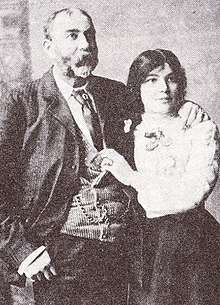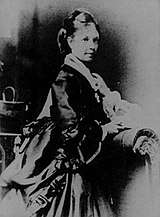Samuel Herbert Dougal
Samuel Herbert Dougal (15 May 1847 - 14 July 1903), a notorious womanising convicted forger was a soldier who used his medal winning administrative skills to ill effect. He married three times, the first two wives dying in suspicious circumstances. Dougal spent little time before replacing them in other relationships where he sired numerous illegitimate children in addition to his legitimate progeny. Dougal's downfall came soon after a servant of his sought an affiliation order for the child she had borne him. The scrutiny from the court process revealed that the woman he had been living with as man and wife was not in fact married to him. Indeed, she had not been seen by her own relatives for four years despite her funds and share holdings having been cashed in over the same period. The discovery of this woman's murdered corpse in the grounds of their home precipitated the murder trial that ended in Dougal's conviction as a murderer and his hanging for his crime soon after.
Samuel Herbert Dougal | |
|---|---|
 Samuel Dougal, pictured with Georgina Cranwell, c. 1902 | |
| Born | 15 May 1847 Bow, London, United Kingdom |
| Died | 14 July 1903 (aged 56) Chelmsford Prison, Essex, United Kingdom |
| Nationality | British |
| Occupation | Royal Engineer, Clerk |
| Known for | Forgery, deception, predatory sexual drive |
| Criminal status | Executed |
| Criminal charge | Murder |
| Penalty | Death by hanging |
| Details | |
| Victims | Camille Cecile Holland |
| Date | 19 May 1899 |
Date apprehended | 18 March 1903 |
Early life
Samuel Herbert Dougal was the oldest son of Samuel Dredge Dougal (1826–1900) and Maria Josephine Thompson (1822–1897) born in Bow, London on 15 May 1847. At age 19 he enlisted for 12 years in the Royal Engineers and was initially assigned to survey work with the Ordnance Survey. Whilst posted on this work he married (Lovenia) Martha Griffiths at Mold, Flintshire in 1869. The first of Samuel's legitimate children, Charles Herbert Dougal was born in London, when he was elsewhere in 1871. Many other children were born but not all survived long. By choice, Samuel Dougal transferred to Halifax, Nova Scotia in 1877 and subsequently extended his period of service to 21 years. In June 1885 his wife, Martha, died suddenly having had no prior illness or health condition. Two months later, Samuel Dougal married a young Irish woman, Mary Herberta Boyd, who already had a child of her own. Two months from this event, Mary too was dead, dying inexplicably suddenly in October 1885. Mary was rapidly buried at Fort Massey, the place where her predecessor was also rapidly buried. Samuel nevertheless persuaded another woman, Bessie Stedman,[1] to be his 'mate' and she initially returned with Dougal to England when he was posted to Aldershot. Nevertheless, she removed herself back to Canada after suffering abuse from Dougal. In March 1887, Dougal was discharged from the Royal Engineers.[2]
Civilian life
On discharge from the Royal Engineers, Samuel Dougal gave what appeared to be his youngest brother's address in Battersea as his destination. He soon moved from here to the Isle of Wight where he set up home with a woman named Marian Paine, a widow with children. She subsequently bore several illegitimate children of Dougal's. With Marian, Dougal acquired the goodwill and furniture of the Royston Crow public house on Baldock Street in Ware, Hertfordshire in 1889. A fire at the Royston Crow, following soon after an earlier one that had been extinguished by a business neighbour, raised suspicions of arson. Dougal was charged with defrauding an insurance company but was found not guilty. Nevertheless, the local magistrates refused to return his licence. In 1892 Marian left Dougal owing to his bad behaviour towards her. Later in the same year he married Sarah Henrietta White a 20 year old Irish woman. With Sarah, Dougal began his career of defrauding easily victimised women. He persuaded a woman called Emily Booty to live with him as his wife but promptly spent her money and humiliated by bringing his real wife to live at their joint home. Miss Booty suffered further public humiliations attempting to regain possession of her property. Dougal moved on but did not give up his schemes until he was found guilty of stealing and forging cheques. He was sentenced to twelve months prison with hard labour to be served at Pentonville Prison. Faking a suicide attempt, he was removed to Cane Hill Lunatic Asylum where he served most of his sentence. He was discharged perfectly sane on 8 December 1896. Again his youngest brother helped him by providing employment for him at Biggin Hill, Kent and he was here until 1898 by which time he had lined up his next target, 56-year-old Camille Cecile Holland.

Miss Holland is believed to have advertised for a husband to which Dougal presented himself as a candidate. Having ensnared her, though he was still legally married to Sarah, they first set up home as a married couple near Brighton. Soon they were in negotiations to purchase Coldhams, a property in Clavering, Essex. Miss Holland was to finance the deal and insisted her name appear on the contract documentation. As Mr and Mrs Dougal, Miss Holland and Samuel Dougal found lodgings at Saffron Walden whilst Coldhams was renovated. On 24 April 1899 Miss Holland and Samuel Dougal moved into the property that they had renamed Moat House Farm - or Moat Farm as it was to become known.
Discovery
In early 1903, questions began to arise as to the whereabouts of Camille Cecile Holland and the fact that cheques and other financial instruments were being presented with what purported to be her signature. No one had seen her since 19 May 1899 when the woman servant, who had rebuffed Samuel Dougal's sexually motivated attack on her, refused to be left alone with him present. Miss Holland had left in a pony and trap with Dougal driving saying to the servant that she would not be long. Dougal returned alone and claimed that Miss Holland, whom the servant was led to believe was 'Mrs Dougal', had gone away to London. The servant's mother recovered and removed her daughter from Moat Farm the following day. Subsequently, a series of young women were to suffer similar fates at the hands of Dougal who, no sooner had they begun in their role as servant than they were preyed upon by Dougal. Within three months of his appointing Georgina "Kate" Cranwell as a servant, he had made her pregnant. She left six months after this and her baby was born in December 1902. Dougal evidently refused to provide for this child so Kate sought an affiliation order on 27 January 1903. Information given to the court revealed that Camille Cecile Holland was not married to Dougal resulting in some further enquiries being made about him. Initially, the enquiries centred on fraud and forgery until it became quite evident that Miss Holland was missing and had not been heard from by her relatives for over four years. Weeks of digging ensued at the Moat Farm until 27 April 1903 when Miss Holland's body was found. Following an inquest where it was discovered that Miss Holland had suffered a bullet wound to the head, Dougal was committed for trial on 22 June 1903.
Conviction and execution
On 23 June, with the unanimous verdict of the jury, Dougal was found guilty of murder and sentenced to death. He was hanged by the public executioner William Billington at Chelmsford Prison on 14 July 1903.[3]
References
- "Guilty! Introducing the Biggest Scoundrel in Victorian Britain". The Independent. 23 September 2012. Retrieved 28 December 2017.
- Oldridge, M. W. (2012). The Moat Farm Mystery: The Life And Criminal Career Of Samuel Herbert Dougal. Stroud: History Press. ISBN 9780752466293. OCLC 795181831.
- F. Tennyson Jesse (1928). Trial Of Samuel Herbert Dougal.
External links
- British Executions case file pertaining to Samuel Herbert Dougal